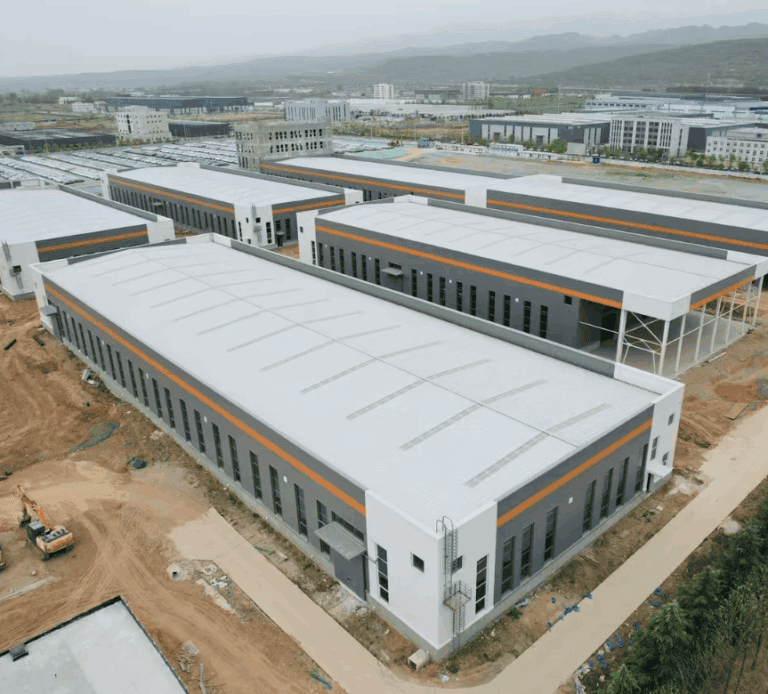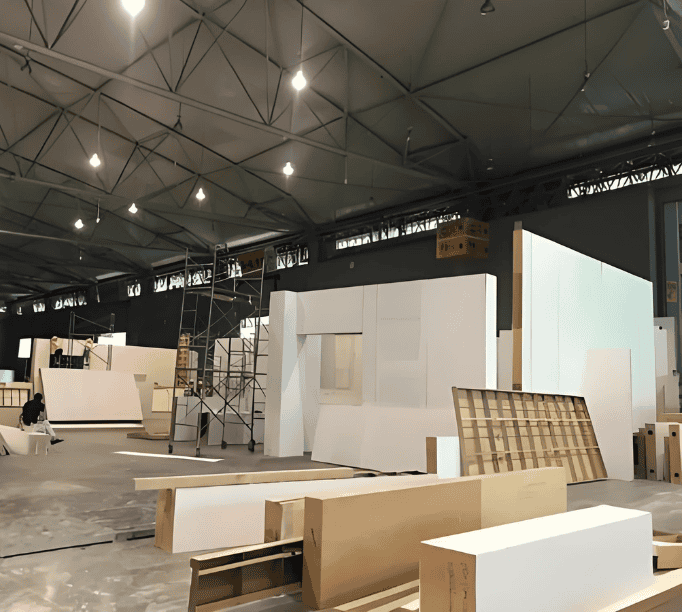Yes, you can install metal roofing directly on rafters—but only if your structure meets strict requirements. Rafter spacing, load capacity, insulation, and thermal expansion all play a role in whether the roof lasts decades or fails within a few years.
In this guide, you will learn:
- The essential conditions for direct installation on rafters
- The three non-negotiable checks before placing panels
- Step-by-step instructions for installation with fasteners and insulation
- Common myths that cause premature roof failures
- When to rely on professional installation instead of DIY
- How different roofing materials, from steel to aluminum, perform on rafters
This article is based on industry standards and practical experience from SteelPRO – Steel Structures & PEB Manufacturer. Our goal is to give you clear, reliable guidance—not just theory—so you can make the right decision for your project.
Can You Put Metal Roofing Directly on Rafters? Yes, But With Conditions
Metal roofing can be installed directly on rafters, but only if certain conditions are met. The key factors are rafter spacing, load capacity, and thermal control. If these conditions are ignored, the roof may sag, leak, or fail within a few years.
Steel rafters are generally stronger and more reliable than wood rafters. For example, a typical 2×4 wood rafter may not provide the same load resistance as a steel rafter, especially in snow or wind-prone areas. This is why PEB structures designed by manufacturers already calculate these parameters during factory engineering.
Rafter Spacing and Panel Capacity
| Roofing Panel Type | Maximum Rafter Spacing | Notes |
| Corrugated panels | ≤ 5 ft (1.5 m) | Requires closer spacing |
| Standing seam panels | ≤ 8 ft (2.4 m) | Suitable for wide-span steel structures |
| 2×4 wood rafters | ≤ 2 ft (0.6 m) | Not recommended for large spans |
| Steel rafters (factory design) | 5–8 ft (1.5–2.4 m) | Load-tested & certified |
Takeaway: Before installing, always measure rafter spacing center-to-center. If rafters are too far apart, add purlins for extra support.
The 3 Non-Negotiables Before Installing Metal Roofing on Rafters
Installing metal roofing directly on rafters requires more than strong panels. Three non-negotiable checks determine whether the roof will last decades or fail within years.
Structural Integrity Check
Your rafters are the load-bearing backbone of the roof. If spacing or fasteners are not correct, panels can sag or detach.
- Rafter Spacing Rule
- Corrugated panels: max 5 ft (1.5 m)
- Standing seam: max 8 ft (2.4 m)
- Wood rafters (2×4): max 2 ft (0.6 m)
- Always measure spacing center-to-center, just like ladder rungs. Too far apart = wobbling, too close = wasted material.
- Fasteners & Clips
- Class 5 roof screws → corrosion-resistant, tested for outdoor use.
- Sliding clips → recommended for long panels to allow expansion.
- Rigid screws only → risk of panel warping over time.
Tip: Always check if fasteners meet factory specifications (ISO / CE). Manufacturer-tested solutions guarantee long-term stability.
Thermal Bridging & Condensation
Steel conducts heat 300× faster than wood. Without protection, rafters become “cold bridges,” leading to condensation, rust, and mold.
Solutions for Condensation Control:
| Material / Method | Best Use | Limitations |
| Anticon blanket | Combines insulation & anti-condensation lining | Higher cost |
| Sarking (reflective foil) | Hot climates; reflects radiant heat | Less effective in cold regions |
| Breather membrane | Allows vapor escape, prevents water ingress | Needs proper sealing |
| Spray foam insulation | Strong barrier, reduces energy loss | Requires professional installation |
Energy Star research shows that spray foam insulation can reduce heating and cooling costs by up to 15% annually.
For industrial or large-span steel buildings, factory-recommended insulation systems provide the most reliable results.
Expansion & Contraction
Metal expands and contracts with temperature changes. A 100-ft steel roof may expand up to 1.5 inches. Without flexible fasteners, panels may buckle.
- Use sliding clips instead of rigid screws.
- Maintain 6–12 in overlaps depending on slope.
- Leave ¼-inch gaps at trim joints.
Ignoring these practices often leads to creaks and warped panels within a year.
How to Install Metal Roofing on Steel Rafters (Step-by-Step)
Installing metal roofing directly on steel rafters requires preparation, correct layering, and attention to fasteners. Below is a structured process based on manufacturer standards and field practice.
Step 1: Pre-Installation Checkup
Before adding panels, check your steel rafters carefully:
- Rafter spacing: must be within panel limits (corrugated ≤ 5 ft, standing seam ≤ 8 ft).
- Condition: look for rust, dents, or bends. Light surface rust can be sanded and primed, but bent rafters beyond 1/8 inch per 10 ft need replacement.
- Alignment: measure center-to-center to ensure consistency.
Step 2: Lay the Foundation
A strong foundation prevents leaks and condensation problems:
- Vapor barrier: use self-adhering membrane or synthetic underlayment. Overlap seams by 6 in, ensure no gaps.
- Anti-ponding board: recommended in areas with low roof slope or heavy rainfall. It prevents water accumulation behind rafters.
- Purlins (optional): add horizontal steel supports if spacing is over 4 ft or in regions with high snow load.
Step 3: Panel Installation
Installing panels requires the right sequence and fasteners:
- Starting point: align the first panel at the eaves with 1–1.5 in overhang for drip control.
- Fasteners: use class 5 screws for corrosion resistance and sliding clips for long panels. Clip spacing should follow wind uplift standards (e.g., SPRI 2024).
- Side laps: overlap panel edges by 1.5 in and seal with butyl tape.
- End laps: overlap by 6 in on slopes ≥ 3:12.
- Expansion gaps: leave 1/4 in between panels and trim for thermal movement.
Installation Diagram
A standard installation sequence for metal roofing on steel rafters includes:
- Steel rafters (main structure)
- Optional purlins (extra support for wide spacing)
- Vapor barrier or insulation layer (anticon blanket, sarking, or breather membrane)
- Roof panels (corrugated or standing seam)
- Fasteners and clips (class 5 screws, sliding clips)
- Sealants and overlaps (butyl tape, end laps)
This layered design prevents condensation, ensures load capacity, and meets factory specifications for long-term durability.
Metal Roofing Myths: What YouTube Won’t Tell You
Online tutorials often oversimplify metal roofing installation. Below are three common myths and why they are misleading, based on manufacturer standards and real project data.
Myth 1: Skip the Underlayment to Save Time and Money
Underlayment is essential. Studies show that 78% of premature roof failures are due to missing or inadequate underlayment (Roofing Contractor Magazine, 2024).
- Protection: blocks condensation and prevents rust. Even tiny water droplets can corrode screws over time.
- Fire resistance: synthetic underlayment can resist embers in wildfire zones.
- Cost vs risk: saving $0.50 per sq ft on materials can lead to thousands in repairs.
Case study: A Colorado rancher skipped underlayment to save costs. Within two winters, condensation created ice build-up that tore seams apart. The repair bill was double the cost of proper installation.
Myth 2: All Metal Roofs Are the Same
Different materials and coatings perform differently. Choosing the wrong one can reduce lifespan by decades.
| Material | Best Use | Not Suitable For | Lifespan |
| Galvalume® (aluminum-zinc alloy) | Dry climates, low salinity | Coastal regions, acid rain | 40–60 years |
| Zincalume® (zinc-aluminum) | Humid climates, mild winters | Heavy industrial pollution | 30–50 years |
| Aluminum sheets | Coastal areas (corrosion-resistant) | Heavy snow load (softer metal) | 30–45 years |
| Steel sheets (factory coated) | Industrial, agricultural, heavy load | Untreated surfaces in wet zones | 40–60 years |
| Colorbond® steel | Australia & hot climates, UV protection | Cold, snowy regions | 30–50 years |
| Alloy roofing sheets | Mixed climate, high strength requirement | Cost-sensitive projects | 35–55 years |
Pro Tip: In coastal zones, use stainless steel fasteners. Standard galvanized screws corrode three times faster in salt air, as confirmed by the ASTM B117 Salt Spray Test.
Myth 3: Metal Roofs Don’t Need Maintenance
Steel roofs last longer than shingles, but “low-maintenance” is not “no maintenance.”
Annual checks should include:
- Gutter cleaning: prevent ice dams and hidden weight.
- Fastener inspection: tighten loose screws and reseal.
- Tree clearance: keep branches at least 6 ft away to avoid scratches and rust spots.
Fun fact: A single pine needle trapped against a seam can create a rust spot in just 18 months (SPRI Case Study #2217).
When to Call Professionals for Metal Roof Installation
Even experienced DIY builders reach a point where professional support is safer and more cost-effective. Use the following tests to decide whether you should hire experts.
The 3-Question Litmus Test
Ask yourself these questions before attempting installation:
- Snow load: Does your region get more than 18 in of snow each year? One square foot of wet snow can weigh up to 21 lbs. Steel rafters in snow-prone areas need 20–30% higher load capacity.
- Coastal air: Are you within 5 miles of saltwater? Salt exposure corrodes steel up to 8× faster. If your car rusts in less than five years, your roof needs marine-grade coatings.
- Roof slope: Is your roof pitch below 3:12? Low slopes trap water and debris, increasing leak risk unless sealed with precision.
If you answer yes to any of these, professional installation is strongly recommended. A DIY repair after failure averages $4,200—double the cost of hiring experts upfront (Roofing Contractor Magazine, 2024).
DIY vs Professional Installation
DIY metal roofing may seem cost-saving, but risks include:
- Incorrect fastener spacing: leads to warped or loose panels.
- Missing insulation layers: causes condensation and rust.
- Safety hazards: lifting panels without cranes or harnesses.
Professional installation by certified manufacturers ensures:
- Correct load calculations and spacing.
- Factory-standard insulation and sealing.
- Compliance with ISO and CE certifications.
For safe and durable results, work with SteelPRO PEB – Certified Steel Structures & PEB Manufacturer. We provide factory-direct supply and wholesale pricing for metal roofing projects, ensuring long-term performance and warranty-backed protection.
Factory-Engineered Solutions for Metal Roofing on Rafters
Most problems with metal roofing on rafters are not caused by the panels themselves—they come from wrong rafter spacing, weak fastening, and poor condensation control. These are exactly the mistakes that make many DIY or generic supplier projects fail within a few years.
A recent industry survey showed that over 70% of premature roof failures were due to incorrect installation methods, not material defects. For example, using the wrong screws or skipping a moisture barrier often leads to leaks, rust, and costly repairs. The repair bill can be double the cost of a correct installation.
At SteelPRO – Certified Steel Structures & PEB Manufacturer, every roof system is factory-engineered to handle spacing, fastening, and insulation requirements before it leaves production. That means you get a solution designed for direct rafter installation, not a one-size-fits-all panel.
We provide:
- Factory-engineered spacing and fastening design
- Correct underlayment and insulation package
- ISO and CE certified manufacturing standards
- Long-term durability backed by up to 50 years of warranty
Contact us today to get your factory-direct roofing package and avoid the costly mistakes of trial-and-error. Build once, build right, and secure a roof that lasts for decades.

